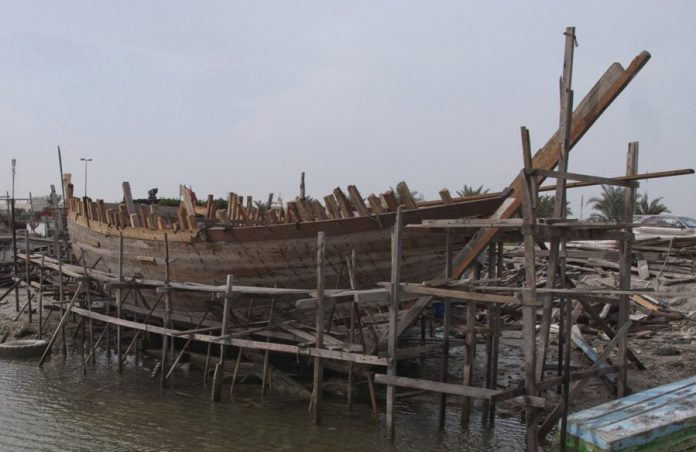A visit to Bahrain is never complete if one misses out the Dhow Building yard. Hidden behind the high fence by the Khalifa Al Kabeer Highway next to the Fishermen’s Port in Muharraq is the oldest and the only Dhow building yard of the Kingdom of Bahrain. The high raised masts of the completed dhows welcome the visitors to the busy yard where the timbers lying around and the melody of the gentle sea breeze tells you a different story about a seafaring nation.
“Making Dhow has been part of our traditions. My uncle had been making them and now me and my brother have started with him as well.” says Ibrahim the dhow building expert and the owner of the yard, who was more than willing to share with us the past, the present and the future of the dhow building industry. There was a time when Mohammed Ali, Ibrahim’s uncle continued making wooden dhows and Ibrahim with his brother Hassan had moved on with the fiber glass boats. It was again when a request from Qatar came in, that the building of traditional dhows began at Ibrahim’s yard. “It takes almost 2 years to finish one dhow. But the effort taken is worth it and everyday is a new experience.” Proudly showing us the finished dhow awaiting a last coat of polish, Ibrahim narrated the experience behind the unique builds.
In modern times the fiber glass boats have taken over the usage of traditional wooden dhows. Even though the wooden dhows are more durable, the cost that comes along with the building and the yearly maintenance is not an easy take. “Early days a dhow would come close to 40,000BHD and now the price would be close to 250,000BHD”. Ibrahim noted. “The raw materials used for building dhows are complicated and not easy to find.” He explains. “All the raw materials including the best teak wood used for making dhows used to come from India. But now with restrictions imposed, it has been very difficult to find the right material for building them.” he shared with us one of the challenges the dhow industry currently face.
A 100 feet boat fit for the kings was at its initial stage in the yard. “Everybody says that all boats are the same, but for us each of them is unique. It could be the length or the design. It’s all there in our mind and we have learned the art of bringing that to life through ages of experience.” With the straight faced Banoosh to slightly rounded or bend faced Sambuk. Or from the Jebut to the ancient mariners classic favorite Betheel, dhows do bear visible difference from each other. “The major purpose of dhow has always been pearling. It is also used for fishing, passenger & cargo transportation and diving.” says Ibrahim. With the deep rooted pearling traditions of Bahrain, it’s no wonder that the dhow industry has been closely associated with the heritage of the Kingdom.
4 years back, from this very own building yard 2 traditional dhows set its smooth sail to the vast ocean commemorate the nation’s cultural and maritime heritage. And to have the actual glimpse of this fast fading traditional art of the Kingdom, one needs to be at the Dhow building yard in Muharraq. The ancient dhows well set against the Arad fort dotting the horizon is the best souvenir one can take home on their visit to this beautiful island nation – Kingdom of Bahrain.

